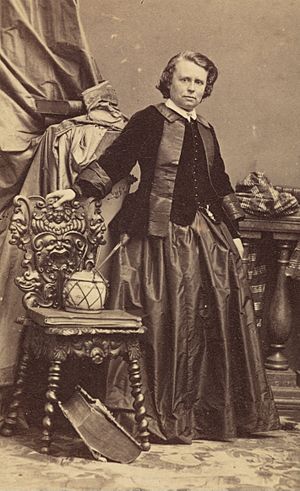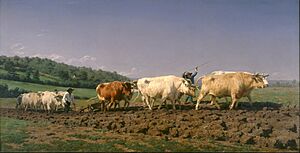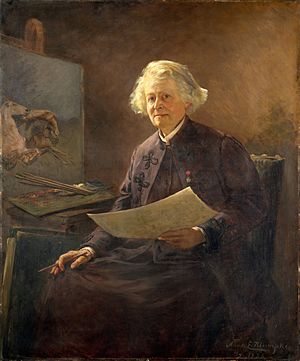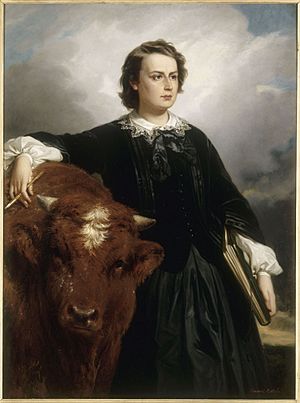Rosa Bonheur facts for kids
Quick facts for kids
Rosa Bonheur
|
|
|---|---|

Photograph of Rosa Bonheur by André Adolphe-Eugène Disdéri, c. 1863
|
|
| Born |
Marie-Rosalie Bonheur
16 March 1822 Bordeaux, France
|
| Died | 25 May 1899 (aged 77) Thomery, France
|
| Known for | Painting, sculpture |
|
Notable work
|
Ploughing in the Nivernais, The Horse Fair |
| Movement | Realism |
Rosa Bonheur (born Marie-Rosalie Bonheur; 16 March 1822 – 25 May 1899) was a famous French artist. She was best known for her paintings of animals. She also created sculptures in a realistic style. Her famous paintings include Ploughing in the Nivernais, which was first shown in Paris in 1848. This painting is now in the Musée d'Orsay in Paris. Another well-known work is The Horse Fair, which was shown in 1853 and is now in the Metropolitan Museum of Art in New York City. Many people thought Rosa Bonheur was the most famous female painter of her time.
Rosa Bonheur was known for her independent lifestyle. She lived with her close friend Nathalie Micas for over 40 years. After Nathalie's death, she lived with the American painter Anna Elizabeth Klumpke. Bonheur was also known for wearing practical clothing, like trousers, which was unusual for women in her era.
Contents
Early Life and Art Training
Rosa Bonheur was born on 16 March 1822 in Bordeaux, France. She was the oldest child in a family of artists. Her mother, Sophie Bonheur, was a piano teacher. Rosa's mother passed away when Rosa was eleven years old. Her father, Oscar-Raymond Bonheur, was a landscape and portrait painter. He strongly supported his daughter's artistic talents.
The Bonheur family followed a Christian-socialist group called Saint-Simonianism. This group believed in educating women and men equally. Rosa's siblings also became artists. Her brothers, Auguste Bonheur and Isidore Bonheur, painted and sculpted animals. Her sister, Juliette Bonheur, also painted animals.
In 1828, when Rosa was six, her family moved to Paris. Rosa was a very active child and found it hard to learn to read. However, she loved to sketch for hours with paper and pencil, even before she could talk. Her mother helped her learn to read and write by asking her to draw a different animal for each letter of the alphabet. Rosa said these lessons made her love drawing animals.
Rosa often caused trouble at school and was expelled many times. After a short time working as a seamstress at age twelve, her father decided to teach her painting himself. He let her follow her interest in animals. He even brought live animals to their art studio so she could study them.

Rosa's art training followed the usual path of the time. She started by copying pictures from drawing books and sketching plaster models. As she got better, she studied farm animals like horses, sheep, cows, and goats. She sketched them in the fields around Paris. When she was fourteen, she began copying famous paintings at the Louvre museum. She especially liked the works of Nicolas Poussin and Peter Paul Rubens.
To truly understand animals, she studied their anatomy (how their bodies are built). She went to the slaughterhouses in Paris and even dissected animals at a veterinary institute. She made detailed drawings that she used later for her paintings and sculptures. During this time, she became friends with two famous animal scientists, Étienne Geoffroy Saint-Hilaire and Isidore Geoffroy Saint-Hilaire.
Achieving Early Success

A special project from the French government led to Rosa Bonheur's first big success. This was the painting Ploughing in the Nivernais, shown in 1849. It is now in the Musée d'Orsay. Her most famous work, The Horse Fair, was finished in 1855. It is a very large painting, measuring about 8 by 16 feet (2.4 by 4.9 meters). It shows a horse market in Paris, with the Pitié-Salpêtrière Hospital in the background. A smaller version of this painting is in the National Gallery in London.
The Horse Fair brought Rosa Bonheur international fame. In the same year, she traveled to Scotland and met Queen Victoria, who admired her art. In Scotland, Rosa made sketches for later paintings like Highland Shepherd (1859) and The Highland Raid (1860). These paintings showed a way of life in the Scottish highlands that had changed a century earlier. They were very popular with people in the Victorian era.
Rosa Bonheur showed her art at the 1893 World's Columbian Exposition in Chicago, Illinois. She became friends with American sculptor Cyrus Edwin Dallin in 1889. Together, they sketched animals and people from Buffalo Bill Cody's Wild West Show. In 1890, Bonheur painted Buffalo Bill Cody riding a horse.
Even though she was more popular in England than in France, she received a high honor from France. The Empress Eugénie gave her the French Legion of Honour in 1865. She was promoted to Officer of the order in 1894. Rosa Bonheur was the first female artist to receive this important award.
Art Patronage and Market
Rosa Bonheur worked with an art dealer named Ernest Gambart. In 1855, he brought her to the United Kingdom. He also bought the rights to make copies of her artwork. Many prints of Bonheur's paintings were made by Charles George Lewis, a very skilled engraver.
By 1859, her success allowed her to move to the Château de By near Fontainebleau, not far from Paris. She lived there for the rest of her life. Her house is now a museum dedicated to her work.
Personal Life and Impact
In Rosa Bonheur's time, it was often difficult for women to become artists. By becoming so successful, she helped open doors for other women artists who came after her.
Bonheur was known for wearing men's clothing. She said she chose trousers because they were practical for working with animals. This was part of a movement called Rational dress, which promoted comfortable and practical clothing for women.
She lived with her close friend, Nathalie Micas, for over 40 years until Nathalie's death. Later, she started a close friendship with the American painter Anna Elizabeth Klumpke. At a time when society often judged women who lived independently, Bonheur's open way of life was groundbreaking.

Rosa Bonheur challenged the usual ideas about how women should act and dress. She chose to wear trousers, shirts, and ties, though she did not wear them in her formal portraits. She did not do this because she wanted to be a man. Instead, she felt it gave her the freedom and power that men usually had.
Until 2013, women in France were technically not allowed to wear trousers without special permission. In 1852, Bonheur had to ask the police for permission to wear trousers. This was because she preferred them for visiting sheep and cattle markets to study the animals she painted.
Rosa Bonheur enjoyed activities often done by men, like hunting and smoking. She believed her life as a woman was special and important. She focused on her painting and relied on herself and her female companions. Her independent spirit helped other women artists who did not want to follow society's traditional path.
Rosa Bonheur passed away on 25 May 1899, at age 77, in Thomery, France. She was buried with Nathalie Micas (1824 – 24 June 1889), her lifelong friend, in Père Lachaise Cemetery in Paris. Anna Klumpke was Bonheur's only heir. Klumpke later joined Micas and Bonheur in the same cemetery after her own death. Their shared tombstone reads, "Friendship is divine affection." Many of Bonheur's paintings that had not been shown publicly were sold at an auction in Paris in 1900.
For much of the 20th century, Rosa Bonheur's art was not as popular. However, her reputation has grown again since the late 1970s. Art historian Linda Nochlin wrote an important essay in 1971 called Why Have There Been No Great Women Artists?, which included a section about Rosa Bonheur.
In 2008, one of Bonheur's paintings, Monarchs of the Forest, sold for over $200,000. On 16 March 2022, Google honored Rosa Bonheur with a special Google Doodle to celebrate 200 years since her birth.
Biographical Works
The first book about Rosa Bonheur's life was published in 1856 by Eugène de Mirecourt. Bonheur herself later added notes and corrections to it.
The second biography was written by Anna Elizabeth Klumpke, who was Bonheur's companion in her last year. Klumpke's book, published in 1909, was later translated into English. It was called Rosa Bonheur: The Artist's (Auto)biography because Klumpke used Bonheur's own words.
Another book, Reminiscences of Rosa Bonheur, was published in 1910. It included many letters between Bonheur and her family and friends. In these letters, she described how she created her art.
List of Works
- Ploughing in the Nivernais, 1849
- The Horse Fair, 1852–55
- Haymaking in the Auvergne, 1853-55
- The Highland Shepherd, 1859
- A Family of Deer, 1865
- Changing meadows (Changement de pâturages), 1868
- Spanish muleteers crossing the Pyrenees (Muletiers espagnols traversent les Pyrénées), 1875
- Weaning the Calves, 1879
- Relay Hunting, 1887
- Portrait of William F. Cody, 1889
- The Monarch of the herd, 1868
Gallery
-
Noon Day Rest (1877), Aberdeen Art Gallery
-
The Pyrenees (1879), Aberdeen Art Gallery
-
The Charcoal Burners (1853), Aberdeen Art Gallery
-
A Stag (1893), National Gallery of Ireland
See also
 In Spanish: Rosa Bonheur para niños
In Spanish: Rosa Bonheur para niños
- Rosa Bonheur Memorial Park
- Prix Rosa-Bonheur (Rosa Bonheur Prize)
- Women artists
Resources
- NMWA.org Collection Profile - Bonheur article and artwork at NMWA.









